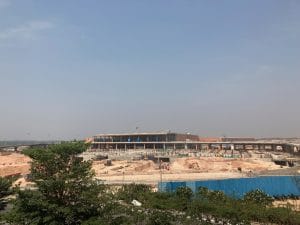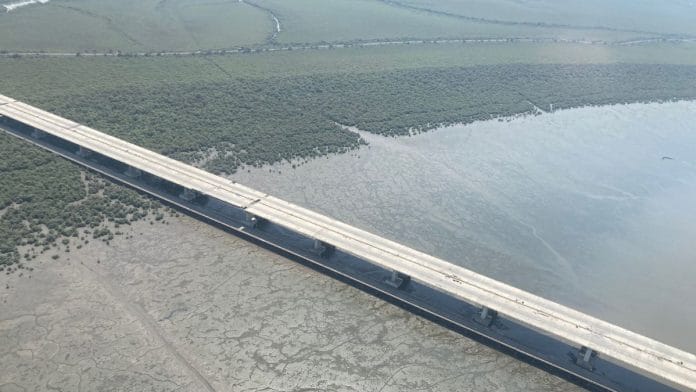As 2022 rolls to a close, I must honestly count my blessings. While the accursed Covid-19 virus that put all our lives on hold did finally catch up with me in January, things have increasingly returned to normal. And normal for me includes a lot of travel. But unlike most recent pre-Covid years, I have not passed through the immigration counter this year.
All my travel in 2022 has been domestic and—through some very memorable drives—I have explored parts of the country I have never seen before.
Witnessing development from the skies
One of the more fascinating things about travelling for me is flying. I have always been a bit of an aviation geek (or #avgeek on social media) and I love looking out of the window. These days, you get to see the transformation of India from the skies: New roads crisscrossing the country, new bridges, new airport terminals, and more.
In March, I took a helicopter ride from the Juhu Airfield in Mumbai to Shillim, next to the hilly resort town of Lonavala. That afforded me a birds-eye view of the urban makeover that Mumbai is getting. Sure, it has made commuting in the city a nightmare, but as my helicopter turned over the Mahalaxmi racecourse, I could see the work happening all across the southern half of the city. I was treated to a great view of the new Trans-Harbour Link—which will connect Mumbai to Navi Mumbai—and the upcoming Navi Mumbai Airport. I’m sure work has gone much ahead in the past eight months.
Landing at Bengaluru’s Kempegowda International Airport a few times this year, I have not only used the new runway but have also seen how quickly work has progressed on the terminal Prime Minister Narendra Modi recently inaugurated. Then, there’s Terminal 1 at New Delhi’s Indira Gandhi International Airport, which is being completely reconstructed. It most certainly needs work, as anyone who has had the unfortunate experience of flying out of the capital in the morning can testify to the utterly insane queues at security.

On some days, when you take off from Delhi in a westerly direction and are seated on the left of the plane, you can notice the long-delayed Dwarka Expressway finally coming to life, as well as the 1,350-kilometre-long Delhi-Mumbai Expressway. Being an automotive journalist is not just about the cars we drive, but also about driving on and experiencing some of these new roads.
Also read: Tata to Hyundai, they’re all tapping into EV dream. Now, we need residential charging points
India’s changing road infrastructure
The past few years have not just witnessed rapid construction of expressways, but also some other amazing highways and roads. This year, I have seen just how excellent the Border Roads Organisation (BRO) has been with Project Vinayak, which connects remote areas on the Chinese and Pakistani borders across the country.
I just returned from Kargil, and while the weather can play spoilsport at times—as avalanches did with my group—BRO kept the road open. Earlier this year in Arunachal Pradesh, I drove on some excellent roads near the Line of Actual Control (LAC)—roads good enough for me to want to return to that corner with a performance car. But even other smaller roads in non-sensitive areas of the country have improved dramatically. My drive through Dakshina Kannada and Kerala’s Wayanad district, for instance, was blessed with very good surfaces for the most part.
It is true our complaints about municipal corruption and high traffic loads are not unfounded, as roads have deteriorated tremendously. But most state and national roads are excellent, as are roads under the Pradhan Mantri Gram Sadak Yojana (PMGSY). In fact, many PMGSY roads should make municipal councillors blush. Even the hated ‘paver blocks’ in Mumbai are not bad when used properly. The top of the critical Zojila Pass near Drass, Ladakh is lined with such paver blocks, which sustain despite heavy traffic that includes vehicles equipped with road-chewing snow chains. However, while the urban renewal of Mumbai is great, that city, along with every other urban conglomeration, has to get its roads in order.
And make no mistakes, given India’s climatic extremes, one should appreciate the civil engineers building roads in the country. Look at Western Europe right now. Road and rail infrastructure is sagging under climate change. Yet, in a country where temperature variations are extreme and vehicles have equally extreme axle loads. Sure, as someone who drives a lot, I have complaints, particularly about expansion joints on North Indian expressways. Although again, these expressways have to deal with surface temperatures as high as 75-80 degrees Celsius in summer and as low as -10 degrees Celsius in winter, which is pretty extreme. Then in some cases, there is poor traffic flow design, particularly in cities because the traffic authorities just don’t have the necessary training. I’d honestly suggest city simulation games like Cities: Skylines for inspiration.
So cutting to the chase, the biggest problem with Indian roads and infrastructure is users—from queue-cutters at airport security lines to a litany of issues on Indian roads. Sure the ‘Cow-Mikazes’ (as I call bovines) on our highways will require immense political will to deal with. But one cannot blame cows for other senseless things on the road. For one, governments and police happily allow far too many—and different—classes of vehicles to operate on major arterial roads. Some of these are of questionable legality, like repurposed old motorcycles and scooters that become goods carriers.
Also read: Gujarat minister excusing road offences does more damage to India’s reputation as traffic hell
Citizens must take onus
Then there’s us, people who will happily travel down the wrong way to save a few minutes, even if it imperils the lives of others. We also take our lives into our own hands by not wearing seatbelts or helmets and endanger not just our lives, but those of our children as well by not strapping them in child seats. Instead, we keep them on our laps while driving or seated in the front seat and then share those pictures and videos on social media because they are ‘cute’.
We are in the middle of an incredible infrastructure-building spree. The US and Europe had that boom in the 1950s and 1960s, and Japan and South Korea in the 1980s and 1990s. But it was China whose physical infrastructure in the last two decades has wowed the most.
And now, it is India’s turn to take China’s place. Projects like the 19-kilometre-long Zojila tunnel through the Himalayas will be world-class because, as we all know very well, it is difficult to dig tunnels in the Himalayas. I saw the work on this tunnel continue despite heavy snowfall a few days prior. But if we truly enjoy world-class—and often world-leading— infrastructure, we, the citizens of this country and users of this infrastructure also need to up our game and be more responsible. ‘Chalta Hai’ (letting things be) will no longer work.
@kushanmitra is an automotive journalist based in New Delhi. Views are personal.
(Edited by Zoya Bhatti)






